- Home
- About
- Map
- Trips
- Bringing Boat West
- Migration West
- Solo Motorcycle Ride
- Final Family XC Trip
- Colorado Rockies
- Graduates' XC Trip
- Yosemite & Nevada
- Colorado & Utah
- Best of Utah
- Southern Loop
- Pacific Northwest
- Northern Loop
- Los Angeles to NYC
- East Coast Trips
- Martha's Vineyard
- 1 Week in Quebec
- Southeast Coast
- NH Backpacking
- Martha's Vineyard
- Canadian Maritimes
- Ocracoke Island
- Edisto Island
- First Landing '02
- Hunting Island '02
- Stowe in Winter
- Hunting Island '01
- Lake Placid
- Chesapeake
- Provincetown
- Hunting Island '00
- Acadia in Winter
- Boston Suburbs
- Niagara Falls
- First Landing '99
- Cape Hatteras
- West Coast Trips
- Burning Man
- Utah Off-Roading
- Maui
- Mojave 4WD Course
- Colorado River Rafting
- Bishop & Death Valley
- Kauai
- Yosemite Fall
- Utah Off-Road
- Lost Coast
- Yosemite Valley
- Arizona and New Mexico
- Pescadero & Capitola
- Bishop & Death Valley
- San Diego, Anza Borrego, Joshua Tree
- Carmel
- Death Valley in Fall
- Yosemite in the Fall
- Pacific Northwest
- Utah Off-Roading
- Southern CA Deserts
- Yosemite & Covid
- Lake Powell Covid
- Eastern Sierra & Covid
- Bishop & Death Valley
- Central & SE Oregon
- Mojave Road
- Eastern Sierra
- Trinity Alps
- Tuolumne Meadows
- Lake Powell Boating
- Eastern Sierra
- Yosemite Winter
- Hawaii
- 4WD Eastern Sierra
- 4WD Death Valley +
- Southern CA Deserts
- Christmas in Tahoe
- Yosemite & Pinnacles
- Totality
- Yosemite & Sierra
- Yosemite Christmas
- Yosemite, San Diego
- Yosemite & North CA
- Seattle to Sierra
- Southwest Deserts
- Yosemite & Sierra
- Pacific Northwest
- Yosemite & South CA
- Pacific Northwest
- Northern California
- Southern Alaska
- Vancouver Island
- International Trips
- Index
- Tips
- Books
- Photos/Videos
- Search
- Contact
Floreana Island, Ecuador
Thursday, March 23, 2023 - 6:30pm by Lolo
0 miles and 0 hours from our last stop - 1 night stay
Travelogue
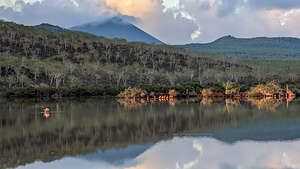 Flamingos on a salt lagoonSometime during the night, we said goodbye to Isabela Island, cruised around its southern tip, and headed southeast to Floreana Island, one of the most southern islands in the Galapagos.
Flamingos on a salt lagoonSometime during the night, we said goodbye to Isabela Island, cruised around its southern tip, and headed southeast to Floreana Island, one of the most southern islands in the Galapagos.
It was the roughest passage we had had so far, but still more of a rocking-us-to-sleep type motion than anything causing sea sickness. March is one of the calmer times, which is one of the many reasons we chose to visit this time of the year.
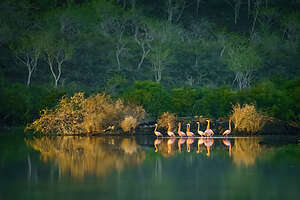 Morning sun lights up the flamingosWe began our day with an early morning wet landing on Punta Cormorant, a beautiful olivine green beach on the north side of Floreana Island. The green is from olivine crystals, which are volcanically-derived silicates of magnesium and iron.
Morning sun lights up the flamingosWe began our day with an early morning wet landing on Punta Cormorant, a beautiful olivine green beach on the north side of Floreana Island. The green is from olivine crystals, which are volcanically-derived silicates of magnesium and iron.
From there we hiked for about a half mile to a lovely saltwater lagoon where flamingos and other wading birds hang out. The particular species of flamingo in the Galapagos is the American flamingo, and it can usually be found in these salty lagoons during the nesting period, which lasts from March to July.
This lagoon is a great habitat for flamingos for several reasons.
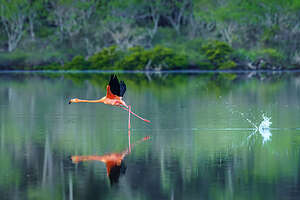 Flamingo running across the surfaceFirstly, it is hypersalinic, meaning that it is even saltier than the ocean. This is because the lagoon is quite shallow, so as the water evaporates, the salt becomes very concentrated. Since pink shrimp love this very salty water, so do flamingos because that’s what they love to eat.
Flamingo running across the surfaceFirstly, it is hypersalinic, meaning that it is even saltier than the ocean. This is because the lagoon is quite shallow, so as the water evaporates, the salt becomes very concentrated. Since pink shrimp love this very salty water, so do flamingos because that’s what they love to eat.
It is that diet of pink shrimp, which have a carotenoid pigment, that gives flamingos their characteristic bright pink color. The more carotenoid they ingest, the pinker they get.
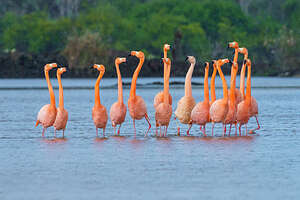 Getting ready to danceSecondly, in order to mate, flamingo colonies need shallow water to perform their synchronized courtship dances, which they actually were doing this morning.
Getting ready to danceSecondly, in order to mate, flamingo colonies need shallow water to perform their synchronized courtship dances, which they actually were doing this morning.
It’s an amazing thing to watch. Although they have 136 different dance moves in their repertoire, they usually use just a few. Things usually get started when the tallest male in the group stands up very straight and starts swinging his head back and forth, trying to get the rest of the group to join in. This is called head flagging. Sometimes it works and sometimes it doesn’t. However, when it does, it is incredible - dozens of flamingos stepping along together as if in a parade, heads turning side to side, bobbing up and down - all sizing up their fellow dancers to evaluate their moves.
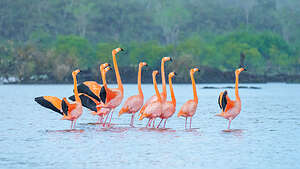 Synchronized courtship danceFun fact: a group of flamingos is called a “flamboyance.” I can’t think of a more appropriate name.
Synchronized courtship danceFun fact: a group of flamingos is called a “flamboyance.” I can’t think of a more appropriate name.
Unfortunately, for me at least, the flamingos were all the way on the other side of the lagoon. This is where those long telephoto lenses that everyone else in the group had came in handy. I, however, did surprisingly well with my trusty Google Pixel 7 Pro.
But until I saw Herb’s photos, I didn’t even notice that they had black-tipped wings.
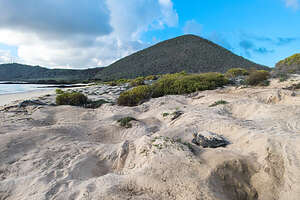 Sea Turtle nestsWe continued along the trail to the sea on the other side of Punta Cormorant to a very pretty, soft sand beach.
Sea Turtle nestsWe continued along the trail to the sea on the other side of Punta Cormorant to a very pretty, soft sand beach.
About a 100 yards back from the water there was a large nesting area, where dozens of female sea turtles had used their back flippers to dig nests in the sand where they laid and buried up to 100 eggs, which incubate in the warm sand for about 60 days.
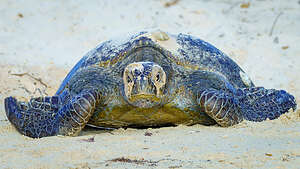 Sea Turtle crawling to the seaOnce she has buried them, she slowly drags herself back to the sea.
Sea Turtle crawling to the seaOnce she has buried them, she slowly drags herself back to the sea.
This was exactly what we were witnessing. For the next 15 to 20 minutes, we watched in awe as she crawled up and over the mounds of sand created by their nests and then slowly but surely made her way across the open expanse of beach. We felt like cheering when she finally reached the sea.
Eventually, when her eggs hatch, the little guys would have to make the same journey, but under much more dangerous circumstances, as predators, such as cormorants, gulls, hawks, and even crabs wait anxiously for them to hatch and consume most of them before they ever reach the sea.
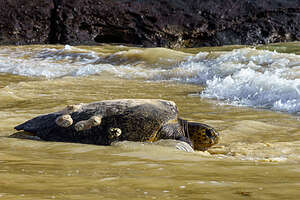 Finally she's thereWow! Not exactly what I would consider good parenting, but then again I am not a sea turtle.
Finally she's thereWow! Not exactly what I would consider good parenting, but then again I am not a sea turtle.
On our way back to the panga, we passed by the salt lagoon again just as it began to pour - our first rain since we had been in the Galapagos. They were literally dancing in the rain, head flagging, bopping up and down, and twisting their bodies around.
Of course, this made the flamingos even more photogenic, so we couldn’t possibly leave. Instead, we stayed a good half hour getting soaked and hoping our cameras stayed dry under our attempts at waterproofing.
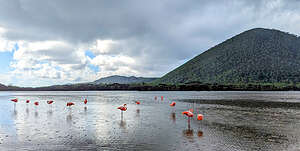 Back to the Salt LagoonIt was worth it. The photos were absolutely stunning.
Back to the Salt LagoonIt was worth it. The photos were absolutely stunning.
After lunch and a brief siesta, we went back out in the pangas for a wet landing at Post Office Bay, the closest thing to civilization we had seen in over a week.
It’s one of the most historically famous island locations in the archipelago. Its origin dates back to 1793, when whalers began the practice of leaving mail in a barrel for homeward-bound ships to collect and deliver.
When they got home, the crew members collecting the mail would then hand deliver the letters to the intended recipients - both as an act of kindness and in the hope that the favor would be returned when they “mailed” something from the Galapagos.
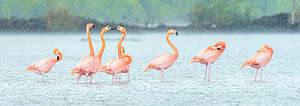 Dancing in the rainToday, the tradition is carried on by tourists, such as us. I had purchased some postcards to send home to our sons and neighbors, which I placed in the barrel, in the hopes that some future traveler from the great state of California would collect it and hand deliver. I did not have high hopes, but what the heck.
Dancing in the rainToday, the tradition is carried on by tourists, such as us. I had purchased some postcards to send home to our sons and neighbors, which I placed in the barrel, in the hopes that some future traveler from the great state of California would collect it and hand deliver. I did not have high hopes, but what the heck.
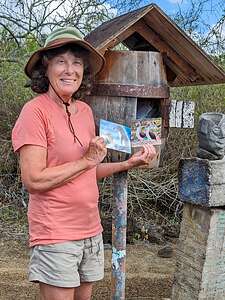 Floreana's historic "Post Office"In return, we were told to select some to hand deliver when we got back home. Everyone kept handing me anything with a California address on it, but I stopped with 6 of them. There was no way I was hand delivering one to San Diego, so I was going to take the more modern approach of putting it in an envelope with a stamp and mailing it.
Floreana's historic "Post Office"In return, we were told to select some to hand deliver when we got back home. Everyone kept handing me anything with a California address on it, but I stopped with 6 of them. There was no way I was hand delivering one to San Diego, so I was going to take the more modern approach of putting it in an envelope with a stamp and mailing it.
On the way back to the ship, we cruised over to an area called the Mirador de la Baronesa (Baroness’s Lookout), a rocky shoreline, where there is a sea lion colony and penguins like to hang out. I’ll get to that later, but first, a little history of the Baroness.
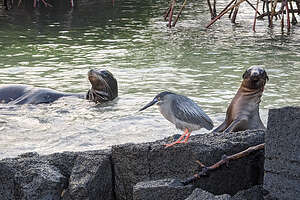 Sea Lions playing with a lava heronThe Baroness was a real person that lived on this island in the 1930s and was a central figure in much mystery and intrigue, and even murder. Today what happened on Floreana Island is referred to as “The Galapagos Affair.”
Sea Lions playing with a lava heronThe Baroness was a real person that lived on this island in the 1930s and was a central figure in much mystery and intrigue, and even murder. Today what happened on Floreana Island is referred to as “The Galapagos Affair.”
Without going into too much detail, Floreana Island was first settled by a German physician named Dr. Ritter and his lover, Dora. They were soon followed by the Wittmers, who gave birth to the first baby on the island. Dr. Ritter, who wanted his privacy, was not happy about their arrival, but they learned to get along.
Fun Fact: The Tip Top IV is owned by the Wittmer family, descendents of the original inhabitants on Floreana
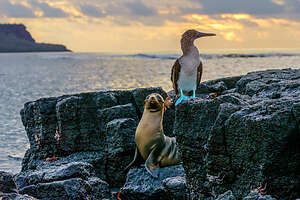 Mirador de la BaronesaHowever, a few years later, a woman, who claimed to be an Austrian Baroness arrived with her two lovers, Robert and Rudolf, who were actually her sex slaves. She wanted to build a grand hotel and transform the island into an adult-themed bacchanalia. Calling herself the “Pirate Queen of the Galapagos,” she would strut around the island scantily clad, with a revolver strapped to her leg, and a whip in her hand.
Mirador de la BaronesaHowever, a few years later, a woman, who claimed to be an Austrian Baroness arrived with her two lovers, Robert and Rudolf, who were actually her sex slaves. She wanted to build a grand hotel and transform the island into an adult-themed bacchanalia. Calling herself the “Pirate Queen of the Galapagos,” she would strut around the island scantily clad, with a revolver strapped to her leg, and a whip in her hand.
She would also sit on the rocky shoreline, which we were now at, watching for passing ships. Often these ships would deliver supplies for the Ritters or Wittmers that never found their way to them after the Baroness first got her hands on them.
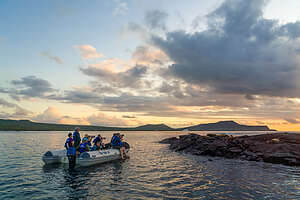 Time to head homeObviously, the Baroness was not very popular on the island.
Time to head homeObviously, the Baroness was not very popular on the island.
Things got worse and worse between the island residents and strange things began to happen. In 1934, the Baroness and one of her lovers just disappeared, leaving behind all their possessions. According to Margaret Wittmer, they left on a strange yacht, but no one else saw this boat and they were never seen or heard from again.
A short time later the Baroness’ other lover left the island on a fishing boat heading for Guayaquil but never arrived. His corpse was found on the deserted island of Marchena.
A few months after, Dr. Ritter died of a mysterious poisoning. According to the Wittmers, he said before dying that his lover had poisoned him.
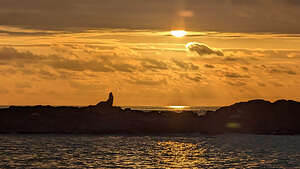 End of another incredible dayTo this day the disappearance of the Baroness and her lover and the circumstances surrounding the deaths of her other lover and of Dr. Ritter remain a mystery.
End of another incredible dayTo this day the disappearance of the Baroness and her lover and the circumstances surrounding the deaths of her other lover and of Dr. Ritter remain a mystery.
My point for digressing with this story, besides the fact that it is quite a story, is that this lovely spot where we were watching the sea lions and penguins play was where the Baroness used to sit for enjoying the panoramic views and watching for visiting delivery ships.
Now it’s just a playground for playful sea lions and seabirds.
The sun was setting. Time for the panga to take us home.
Recap of wildlife we saw today: flamingos, Galapagos Giant Tortoises, sea lions, lava herons, blue-footed boobies
- ‹ previous
- 9 of 13
- next ›
Floreana Island location map in "high definition"
Javascript is required to view this map.
